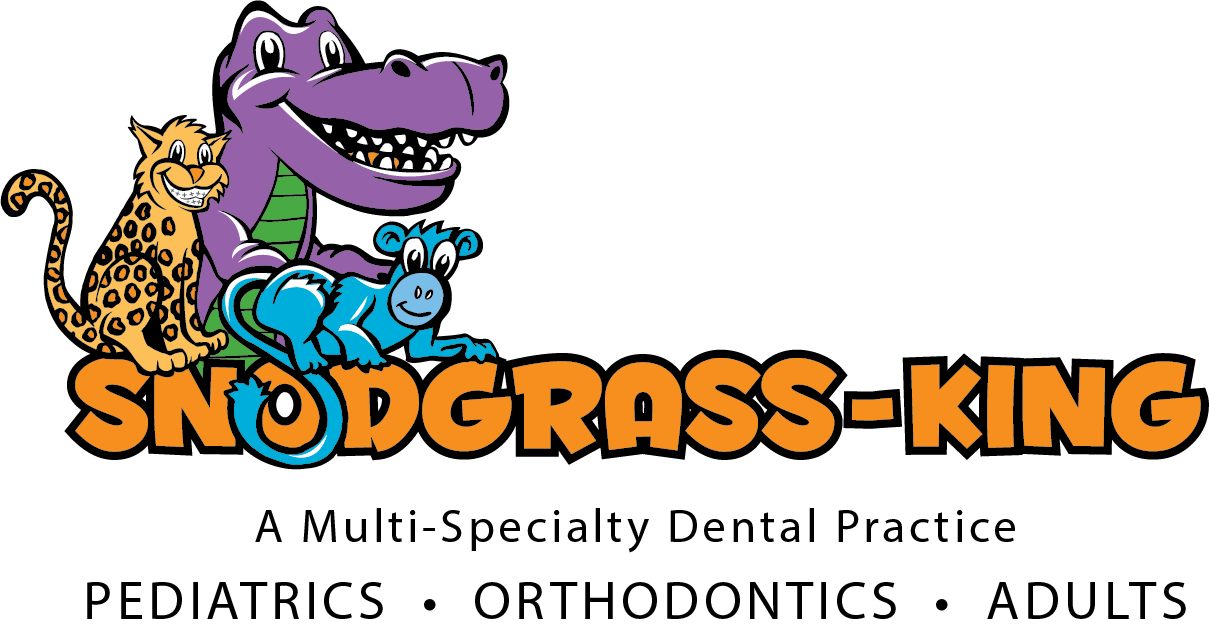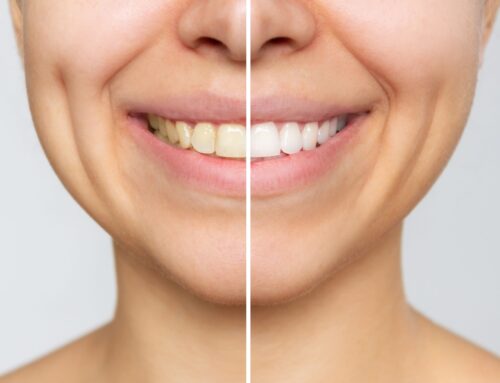Removing Baby Teeth At Home Safely & Painlessly
Removing your child’s baby tooth can feel both daunting and scary! Parents and guardians alike want to ensure that this kind of at-home tooth extraction is without complications, unnecessary pain and with a tear-free experience for their little one.Let’s take a look at some basic tips and tricks to remove baby teeth at home safely and painlessly with the dental experts at Snodgrass-King Dental.
When Is It Time to Pull Out a Baby Tooth?
Determining the perfect moment to pull out a baby tooth, or “milk tooth”, at home is crucial for a safe and comfortable experience for your child. It’s important to wait until the tooth is very loose and wiggles easily. This looseness indicates that the root has dissolved enough for a painless removal. Typically, a tooth is ready for extraction when it can be moved in all directions—front to back and side to side—without causing discomfort.
Here are a few signs that it might be time to help your child with a loose tooth:
- The tooth moves easily when touched or when your child wiggles it with their tongue or clean fingers.
- The emergence of a permanent tooth behind or beneath the baby tooth, pushing it up or forward.
- The baby tooth has been loose for a few weeks.
- Your child complains of the loose tooth interfering with eating or talking.
It’s helpful to involve your child in the process and let them take the lead in wiggling the tooth. Encourage them to play with the tooth using their tongue or clean fingers, as this can quicken the process. However, if there’s any resistance or mouth pain when you attempt to remove the tooth, it’s best to wait a bit longer or seek advice from a dentist.
Remember, each child’s experience losing teeth is unique, and while some might find the anticipation of the tooth fairy’s visit thrilling, others may feel anxious. Patience and gentle encouragement are key.
If at any point you’re unsure whether it’s the right time for an at-home removal or if the tooth appears to be problematic, such as being only partially loose or causing significant pain, it’s best to consult with your child’s dentist for guidance.
How to Get a Baby Tooth Out Fast and Painless Step-by-Step
As mentioned earlier, only attempt to remove baby teeth once you’re sure it’s time for them to come out. Your child shouldn’t have any problem wiggling or moving the tooth around, and no sharp pain when doing so. If it is time for a tooth to come out, try these methods below.
During the removal of a baby tooth at home there are ways to be efficient, and quick, so that there is minimal pain for your child. This can look like pulling out the tooth on the count of three or having calm music in the background! You know your child best, so communicate with them in a way that makes sense to them during the process of removing a baby tooth to curb any anxiety or nerves.
Remember, while home remedies can be effective for extremely loose baby teeth, they should never replace professional care. If there’s any doubt or if complications arise, consult a dentist promptly. Additionally, avoid using any tools or sharp objects to pull a tooth, as this can cause injury or infection.
Follow Up Care After Losing a Tooth
When your child loses their first tooth, it can be both exciting and a bit scary. You’ll want to talk your child through the entire process to help keep them calm. Explain to your child that bleeding is normal after losing a tooth, and you will help them take care of it. Some steps you can take to help ensure the area heals properly include:
- Having your child carefully rinse their mouth with warm salt water.
- Avoid feeding your child foods that could cause irritation or pain, such as spicy foods.
- Incorporate softer foods into their diet for a day or two, like bananas, applesauce, and more.
- Avoid straws and tell your child not to suck on the area so that the blood clot stays intact for the healing process.
- Monitor the area to make sure it is healing properly.
If your child experiences any pain or if you notice redness around the area, make sure to talk to your dentist.
Why Gentle Rinsing Matters
After your child loses a tooth, it’s important to avoid vigorous rinsing or spitting for the first day. Gentle rinsing helps keep the area clean while also protecting the blood clot that forms where the tooth used to be. If the clot gets knocked loose, it can delay healing and lead to more bleeding or even discomfort—think of it as nature’s Band-Aid for your child’s gums. So, encourage your child to swish softly and let the salt water run out of their mouth, instead of forcefully spitting. This gives their mouth the best chance to heal quickly and comfortably.
When to Not Remove a Baby Tooth at Home
While it may be exciting for your child to lose their first tooth, it’s better to be sure it is the right time. You don’t want to remove a baby tooth premature as that may risk further complications for your child. If you pull a baby tooth too soon it can impact the root structure and gum tissue which can mean more trips to the dentist or orthodontists, and more money spent in the long run. Beyond these complications, it can also cause major discomfort, pain, and bleeding for your child.
Here are some key signs to look for when you should NOT remove a baby tooth at home:
Most baby teeth will fall out on their own, but don’t try to force them out if it’s clearly not time. Leave that step to a skilled pediatric dentist who has the resources to remove your child’s baby tooth pain free.
When to See a Pediatric Dentist for Baby Tooth Extraction in Nashville, Tennessee
While many baby teeth can be safely removed at home when they are extremely loose, there are times when it’s best to see a pediatric dentist. If your child’s tooth is only partially loose, causing significant pain or discomfort, or if there are signs of infection such as swelling, redness, or pus, professional intervention is necessary.
If you attempt to remove a baby tooth at home and encounter any difficulties or complications, take the following steps:
- Stop immediately: If you’re unable to remove the tooth, or if your child experiences excessive pain or bleeding, stop the process right away. Continuing may cause unnecessary harm.
- Clean the area: Gently rinse your child’s mouth with warm salt water to help cleanse the area and reduce the risk of infection. Avoid alcohol-based mouthwashes, as these can irritate sensitive gums.
- Control bleeding: If there is significant bleeding, apply gentle but firm pressure with a clean gauze pad or tissue. If bleeding continues for more than 20 minutes, seek professional help.
- Contact a dentist: Don’t hesitate to call your pediatric dentist for advice and care if any complications arise. They can assess the situation and ensure your child receives the appropriate treatment.
When in doubt, it’s always better to err on the side of caution—your child’s comfort and health come first.
Additionally, if a permanent tooth is emerging while the baby tooth remains firmly in place, a dentist can assist in the extraction to prevent misalignment. A pediatric dentist can also provide guidance if there’s uncertainty about the right time for tooth extraction or if you’re concerned about potential complications. It’s always better to err on the side of caution and seek expert advice to ensure the health and safety of your child’s developing smile.
Types of Tooth Extractions
Tooth extractions are categorized into simple and surgical procedures.
Simple Extraction
A simple extraction is when the dentist takes out a tooth that you can see in the mouth. They use tools like elevators and forceps. The tooth is removed from the bone it sits in after cutting the tiny ligament that holds the tooth in place.
Which Teeth Are Harder to Remove: Upper or Lower?
When it comes to tooth extractions, lower teeth—particularly the molars—typically present more of a challenge than upper teeth. This is because lower molars often have multiple roots that may be curved or angled in different directions, making their removal trickier. In contrast, upper teeth usually have straighter roots and are more accessible, which can make their extraction a bit simpler for both the dentist and the patient.
Surgical Extraction
Surgical extractions are for teeth that are not easily accessible, such as impacted teeth. These may require incisions and removal of jawbone for extraction, sometimes sectioning the tooth for removal.
This approach is especially common with teeth that have multiple roots—like molars—where extraction can be more complicated if the roots are curved, crooked, or hook-shaped. In these cases, extra care is needed, as the process may require additional force, increasing the risk of tooth breakage or damage to the surrounding gums and jawbone. Surgical techniques are designed to minimize these risks and ensure the tooth is removed as safely and efficiently as possible.
The Tooth Extraction Procedure
To prepare, consult your dentist to evaluate the tooth and review medical history. Comfortable clothing and a driver for post-procedure transport are recommended, especially if sedation is used.
The procedure starts with anesthesia to numb the area, followed by loosening and lifting the tooth with dental tools, and cleaning the socket post-extraction.
Local anesthesia is used for simple extractions, while sedation options like nitrous oxide or IV sedation can be used for complex cases or anxiety management.
Dental elevators loosen the tooth before forceps are used to gently extract it from the socket. In some cases, the dentist may make incisions and section the tooth to remove it.
Aftercare and Recovery
Procedure aftercare involves managing pain and swelling with medications and ice packs, maintaining oral hygiene with mouthwash or saltwater, and eating a diet of soft foods.
Pain relievers and cold compresses can help manage severe pain and post-extraction symptoms. Physical activity should be limited to aid the healing process.
Procedure aftercare involves managing pain and swelling with medications and ice packs, maintaining oral hygiene with mouthwash or saltwater, and eating a diet of soft foods.
Pain relievers and cold compresses can help manage severe pain and post-extraction symptoms. Physical activity should be limited to aid the healing process. If you experience discomfort, over-the-counter oral analgesics or topical numbing gels can be applied to the gum area according to package instructions to help reduce pain. For additional numbness, ice chips may be used to soothe the area. Should bleeding occur, gently biting down on medical gauze can help control it. Prioritize rest, stick to soft foods, and maintain gentle oral care to support a smooth recovery.
Oral Hygiene
Prioritize oral health with chlorhexidine mouthwash or saltwater rinses, and avoid direct brushing at the extraction site.
Dietary Recommendations
Soft foods are recommended immediately post-procedure, with a gradual return to normal diet as healing progresses. Choose foods like scrambled eggs, mashed potatoes, and steamed vegetables.
Key Takeaways for At-Home Baby Tooth Removal Without a Dentist
- Your child’s tooth is ready to come out when it is extremely loose and can be removed with minimal effort and discomfort.
- Encourage your child to gently wiggle the loose tooth with their tongue or clean fingers to further loosen it, which can make the pulling process smoother.
- If the tooth is ready to come out, use a clean tissue or gauze to hold the tooth and carefully pull it out with a gentle twist. This can help minimize any discomfort and make the experience quick and painless.
- Proper aftercare following an at-home removal is key to recovery and includes maintaining oral hygiene, applying a cold compress to reduce swelling if necessary, and monitoring for signs of infection.
- Celebrate the milestone with your child, perhaps with a small reward or by keeping the tradition of the tooth fairy alive, to make the experience positive and memorable.
Tooth extraction at home can be a simple, pain-free process with the right approach and patience. Encourage self-wiggle, assist only when necessary, and always prioritize your child’s comfort.
From recognizing the right time for a tooth to be pulled and when to see a dentist for extraction, we’ve explored the essentials. As always, good oral hygiene and professional dental advice are paramount for maintaining a healthy and happy smile.
Pediatric Dentist Snodgrass-King in Middle Tennessee
If you think it’s not the right move to remove a baby tooth at home, then contact our offices at Snodgrass-King dental serving Middle Tennessee. Our team of pediatric dentists would be glad to take a look at any problematic or loose teeth, and determine the right course of action. It could be as simple as just giving a baby tooth more time to loosen up or an extraction might be the best choice for your child.
Tooth extractions for children are common, and at Snodgrass-King their comfort and safety is our top priority.
We currently offer services across 4 separate office locations throughout Middle Tennessee (Mt. Juliet, Murfreesboro, Franklin, and Spring Hill). Our areas of expertise include pediatric dentistry, family orthodontics, and adult dentistry. We look forward to meeting you at Snodgrass-King Dentistry.








